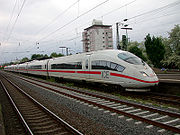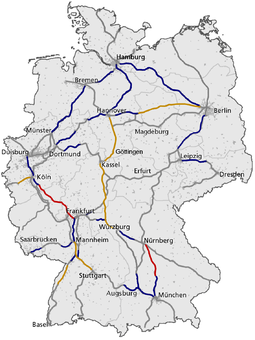
High-speed rail in Germany
Encyclopedia

Germany
Germany , officially the Federal Republic of Germany , is a federal parliamentary republic in Europe. The country consists of 16 states while the capital and largest city is Berlin. Germany covers an area of 357,021 km2 and has a largely temperate seasonal climate...
high-speed lines began shortly after that of the French LGVs (lignes à grande vitesse, high speed lines). Legal battles caused significant delays, so that the InterCityExpress
InterCityExpress
The Intercity-Express or ICE is a system of high-speed trains predominantly running in Germany and neighbouring countries. It is the highest service category offered by DB Fernverkehr and is the flagship of Deutsche Bahn...
(ICE) trains were deployed ten years after the TGV
TGV
The TGV is France's high-speed rail service, currently operated by SNCF Voyages, the long-distance rail branch of SNCF, the French national rail operator....
network was established. The first regularly scheduled ICE trains ran from 2 June 1991 from Hamburg-Altona via Hamburg Hbf – Hannover Hbf – Kassel-Wilhelmshöhe – Fulda – Frankfurt Hbf – Mannheim Hbf and Stuttgart Hbf toward München Hbf on the new ICE line 6. The ICE network is more tightly integrated with pre-existing lines and trains as a result of the different settlement structure in Germany, which has almost twice the population density of France. ICE trains reached destinations in Austria
Austria
Austria , officially the Republic of Austria , is a landlocked country of roughly 8.4 million people in Central Europe. It is bordered by the Czech Republic and Germany to the north, Slovakia and Hungary to the east, Slovenia and Italy to the south, and Switzerland and Liechtenstein to the...
and Switzerland
Switzerland
Switzerland name of one of the Swiss cantons. ; ; ; or ), in its full name the Swiss Confederation , is a federal republic consisting of 26 cantons, with Bern as the seat of the federal authorities. The country is situated in Western Europe,Or Central Europe depending on the definition....
soon after they entered service, taking advantage of the same voltage used in these countries. Starting in 2000, multisystem third-generation ICE trains entered the Netherlands
Netherlands
The Netherlands is a constituent country of the Kingdom of the Netherlands, located mainly in North-West Europe and with several islands in the Caribbean. Mainland Netherlands borders the North Sea to the north and west, Belgium to the south, and Germany to the east, and shares maritime borders...
and Belgium
Belgium
Belgium , officially the Kingdom of Belgium, is a federal state in Western Europe. It is a founding member of the European Union and hosts the EU's headquarters, and those of several other major international organisations such as NATO.Belgium is also a member of, or affiliated to, many...
. The third generation of the ICE has a service speed of 330 km/h (205 mph) and has reached speeds up to 363 km/h (226 mph).
Admission of ICE trains onto French LGVs was applied for in 2001, and trial runs completed in 2005. Since 2008, ICEs service Paris from Frankfurt and Saarbrücken via the LGV Est
LGV Est
The LGV Est européenne is an extension to the French high-speed rail network, connecting currently Vaires-sur-Marne and Baudrecourt , and later Vaires-sur-Marne and Vendenheim . , it is the newest high-speed line in France and still under construction, with of a planned in service...
.
Unlike the TGV
TGV
The TGV is France's high-speed rail service, currently operated by SNCF Voyages, the long-distance rail branch of SNCF, the French national rail operator....
in France or Shinkansen
Shinkansen
The , also known as THE BULLET TRAIN, is a network of high-speed railway lines in Japan operated by four Japan Railways Group companies. Starting with the Tōkaidō Shinkansen in 1964, the network has expanded to currently consist of of lines with maximum speeds of , of Mini-shinkansen with a...
in Japan, Germany has experienced a fatal accident on a high-speed service. In the Eschede train disaster
Eschede train disaster
The Eschede train disaster was the world's deadliest high-speed train accident. It occurred on 3 June 1998, near the village of Eschede in the Celle district of Lower Saxony, Germany. The toll of 101 people dead and 88 injured surpassed the 1971 Dahlerau train disaster as the deadliest accident in...
(1998), a first generation ICE experienced catastrophic wheel failure while travelling 200 km/h near Eschede
Eschede
Eschede is a municipality in the district of Celle, in Lower Saxony, Germany. Situated approximately 15 km northeast of Celle, Eschede lies at the border of the renowned Südheide Nature Park, a protected area of large forests and heaths. Today around 20 small villages are part of the...
, following complaints of excessive vibration. Of 287 passengers aboard 101 people died and 80 were injured in the resulting derailment. Following the crash, all ICE wheels of the faulty design were redesigned and replaced.
Thalys
Thalys
Thalys is an international high-speed train operator originally built around the high-speed line between Paris and Brussels. This track is shared with Eurostar trains that go from Paris or Brussels to London via Lille and the Channel Tunnel and with French domestic TGV trains. Thalys reaches...
trains began running in Germany in 1997, from the Belgian HSL 3
HSL 3
The HSL 3 is a Belgian high-speed rail line. It connects Liège to the German border near Aachen. The line is long, of which are dedicated high-speed tracks....
to Aachen
Aachen
Aachen has historically been a spa town in North Rhine-Westphalia, Germany. Aachen was a favoured residence of Charlemagne, and the place of coronation of the Kings of Germany. Geographically, Aachen is the westernmost town of Germany, located along its borders with Belgium and the Netherlands, ...
and Cologne
Cologne
Cologne is Germany's fourth-largest city , and is the largest city both in the Germany Federal State of North Rhine-Westphalia and within the Rhine-Ruhr Metropolitan Area, one of the major European metropolitan areas with more than ten million inhabitants.Cologne is located on both sides of the...
using the Cologne–Aachen high-speed railway. TGV POS trains began running in Germany in 2007, to Karlsruhe
Karlsruhe
The City of Karlsruhe is a city in the southwest of Germany, in the state of Baden-Württemberg, located near the French-German border.Karlsruhe was founded in 1715 as Karlsruhe Palace, when Germany was a series of principalities and city states...
and Stuttgart
Stuttgart
Stuttgart is the capital of the state of Baden-Württemberg in southern Germany. The sixth-largest city in Germany, Stuttgart has a population of 600,038 while the metropolitan area has a population of 5.3 million ....
using the Mannheim–Stuttgart and Karlsruhe–Basel high-speed lines.
Transrapid
Germany has developed the TransrapidTransrapid
Transrapid is a German high-speed monorail train using magnetic levitation. Based on a patent from 1934, planning of the Transrapid system started in 1969. The test facility for the system in Emsland, Germany was completed in 1987...
, a magnetic levitation train system. The Transrapid reaches speeds up to 550 km/h (340 mph). A test track with a total length of 31.5 km (19.5 mi) is operating in Emsland
Emsland
Landkreis Emsland is a district in Lower Saxony, Germany named after the river Ems. It is bounded by the districts of Leer, Cloppenburg and Osnabrück, the state of North Rhine-Westphalia , the district of Bentheim and the Netherlands .- History :For a long time the region of the Emsland was...
. In China, Shanghai Maglev Train
Shanghai Maglev Train
The Shanghai Maglev Train or Shanghai Transrapid is a magnetic levitation train, or maglev line that operates in Shanghai, China. It is the first commercially operated high-speed magnetic levitation line in the world...
, a Transrapid
Transrapid
Transrapid is a German high-speed monorail train using magnetic levitation. Based on a patent from 1934, planning of the Transrapid system started in 1969. The test facility for the system in Emsland, Germany was completed in 1987...
technology based maglev built in collaboration with Siemens
Siemens
Siemens may refer toSiemens, a German family name carried by generations of telecommunications industrialists, including:* Werner von Siemens , inventor, founder of Siemens AG...
, Germany, has been operational since March 2004.
List of high-speed lines

- Cologne–Aachen high-speed railway (upgraded line, 250 km/h)
- Cologne–Frankfurt high-speed rail line (new line, 300 km/h)
- Erfurt–Leipzig/Halle high-speed railway (new line, 300 km/h, under construction)
- Frankfurt–Mannheim high-speed railway (new line, 300 km/h, in planning)
- Hanover–Berlin high-speed railway (partially new line, 250 km/h)
- Hanover–Würzburg high-speed railway (new line, 250 km/h)
- Mannheim–Stuttgart high-speed railway (new line, 250 km/h)
- Nuremberg–Erfurt high-speed railway (partially new line, 300 km/h, under construction)
- Nuremberg–Munich high-speed railway (partially new line, 300 km/h)
- Karlsruhe–Basel high speed line (new line, 250 km/h, incomplete)
- Hanau-Gelnhausen high-speed railwayHanau-Gelnhausen high-speed railwayThe Hanau-Gelnhausen high-speed railway is currently in planning between Hanau and Gelnhausen. It would start from local tracks in Hanau and connect with the Hannover-Würzburg high-speed railway at Gelnhausen. The railway would improve journey times for trains travelling from Frankfurt-am-Main to...
(new line, 300 km/h, in planning)

